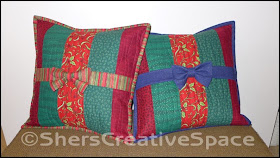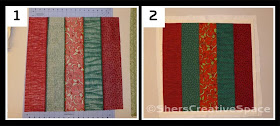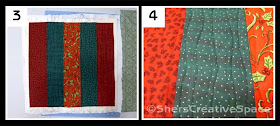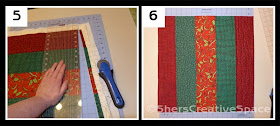This is a fun and easy pattern. The pillow covers are designed so you can easily slip them off and switch out with another style either for a quick change, or to dress up for a holiday. This isn’t just a Christmas pillow, you can make them for any time of year! One pillow can be completed in a few hours for the experienced seamstress.
Click images to enlarge if needed.
Supplies to make one pillow:
18 inch pillow form
5 various fabric strips measuring 4 1/2 x 20 inches for top
5/8 yard of cotton muslin (44” wide)
3/8 yard of fabric (44” wide) for binding, ribbon, & bow
3/8 yard of fabric (44” wide) for backing
3/4 yard of 100% cotton batting or 22” square scrap
(interfacing fleece also works well)
1 yard of medium weight fusible interfacing (20” wide)
Threads to match all fabrics
Walking foot (optional, but helpful)
General supplies:
Scissors, pins, sewing and embroidery needles, fabric marking chalk, pen or pencil, iron & ironing board, sewing machine, cutting mat with ruler & rotary cutter (optional), general sewing supplies
For basting the top layers together, I really LOVE basting spray. I always use “Spray N Bond” brand and it works so much better than pins or stitching for small projects like this. I’ve never had a gummed up needle from this product, and it holds my layers together beautifully while I’m stitching.
Important tips & general instructions:
**Read tips and instructions thoroughly before beginning.
**Iron your fabrics before starting. If you will be pre-washing your fabrics, do not use a fabric softener. It can prevent your adhesive from the fusible interfacing from sticking when fusing. 100% cotton fabrics work best.
**Be sure to follow the manufacturer’s instructions for the fusible interfacing you will be using.
**Be sure to secure the beginning and the ending or your stitching with a couple of back stitches to secure your seams.
Instructions:
1. Piece your five (4 1/2 x 20 in) fabrics together to form a big square using 1/4 inch seam allowance. Press seams open. (image 1)
2. Cut your (ironed) cotton muslin into a square about 22 inches and place on your work surface. Center your 22 inch square of cotton batting over this. Center your pieced top on top of both of these layers, with right side facing up, smoothing as you go. Baste in place for machine quilting. You can use pins or stitching, but I always use the basting spray for small projects like this. It’s quick, easy, and it works very well. (image 2)
3. Take this to your sewing machine and stitch the three layers together. I just made long wavy lines going in the same direction as my seams. You can use any stitch pattern you like, I just really liked this effect. If you have a walking foot, it would be helpful here. If you don’t have one, just be sure to take your time and hold your fabric taught. Sine you are using a thin cotton batting or fleece interfacing, you really shouldn’t have a lot of shifting of layers. (image 3 & 4)
Take this piece back to your work table and cut this down to a perfect 19 inch square. Set this aside for right now. (image 5 & 6)
Note: If you used a little thicker batting than I chose, and your pillow shrunk or shifted and your square will be a little smaller than 19 inches, this is not a big deal, your pillow form will still fit fine. You will just have to adjust your backing fabric to fit the slightly smaller dimension. If you used 100% cotton batting, or the interfacing fleece, this will not be an issue.
4. Cut your remaining fabric and interfacing so it will be ready for stitching as follows:
From the binding and bow fabric
(2) 3 1/4 x 44 inch strips, cut these first
4 1/2 x 19 inch piece
4 1/2 x 13 inch piece
4 1/2 x 2 1/2 inch piece
From the pillow backing fabric
(2) 13 x 19 inch pieces
From the fusible interfacing
(2) 13 x 19 inch pieces
4 1/2 x 19 inch piece
4 1/2 x 13 inch piece
4 1/2 x 2 1/2 inch piece
Refer to diagram below for best cutting layout for the interfacing.
Making the bow and ribbon:
1. Fuse the interfacing to the backs of your bow and ribbon fabrics, which are the 3 pieces that measure 4 1/2 inches wide.
2. Fold and pin the longest piece and the smallest piece, with right sides together. Using a 1/4 inch seam allowance, stitch the pinned edges. Turn right side out and press. For the smaller one, the eraser end of a pencil works well for pushing the fabric through. (image 7)
3. For the remaining piece, you will fold with right sides together, but this time you will stitch the two short ends together and leave a 1 1/2 inch opening in the center. Use a 1/4 inch seam allowance. Press seam open. Keeping this piece with the right sides together, fold so that the seam is in the center, between the folds. Stitch the remaining two edges closed. Clip each corner at an angle close to your stitching. Be careful not to cut through your stitching line. Turn right side out through the 1 1/2 inch hole that you left. Gently push your corners out by using a chopstick or the blunt end of scissors. Hand stitch opening closed and press. (image 8 & 9)
4. Take the smallest piece and fold in half and stitch the loop closed. This time you will leave a 1/2 inch seam allowance and trim it away, close to the stitching. Turn it so the stitching line is on the inside. Before you stitch, make sure that any visible seam will be on the inside of this loop. (image 10)
5. Slip the longer piece (which will be your ribbon) through the loop. Make sure the seam in the loop is toward the back, and the seam for the ribbon is also toward the back. Now take the rectangular piece (bow) and slip it through the loop, on top of the ribbon. Make sure the opening that you stitched closed is at the backside of the bow. Center the bow on the ribbon. (Image 11)
6. Place your pillow top piece, face up, on your table with your stripes vertical. Place your ribbon & bow piece on the center of the pillow top so that it lays horizontal, and is centered between the top and the bottom. Pin each edge to secure. Machine baste the ribbon to the pillow top at each edge, keeping your stitches just under 3/8 of an inch from the edge of the pillow top. (image 12)
1. Fuse the 13 x 19 inch pieces of fusible interfacing to the backside of the 13 x 19 inch fabrics you have chosen for the back of your pillow.
2. On one of the long edges of each backing piece, turn under 1/2 inch to the wrong side, then another 1/2 inch. Pin to secure and stitch down. (image 13)
3. Pin the two back pieces to the backside of the top piece. The wrong side of the back pieces will be facing the wrong side of the pillow top. The hemmed edges on the pillow back will be in the center. You will notice that you have an overlap. This will be the opening that you will put your pillow through. There isn’t even a need to attach a closure when you make your back like this. Machine baste all the way around your pillow. Set aside for now. (image 14)
Applying the binding:
1. Combine the two 3 1/4 x 44 inch strips of fabric to make one long piece. You will do this by placing them on your work table, with right sides together, by forming an “L.” Take a ruler and draw a line on the diagonal at the corner. It will look as if you have a triangle at the corner. Stitch on that line. Cut away the corner about 1/4 inch from the stitching line and iron the seam open
2. Fold one of the short ends of this long strip 1/4” to the wrong side and iron in place, then fold the entire length of fabric in half lengthwise with wrong sides together, and iron.
Before you do the remaining edges, you will stitch this section in place using a 3/8” seam allowance. Begin your stitching at the folded end of your binding, and stop your stitching 3/8" from the corner. I like to run a couple of back stitches at the beginning and ending of my stitching to secure seam in place. Do not exceed your 3/8” seam allowance. Remove project from machine and take back to the table.
Note: If you are familiar with mitered corners when stitching your binding down, you will probably be able to sit at your machine for this step. If you are new to this technique, it will be easier for you to take your project to the table so you can follow the illustrations easily.
4. Flip your binding piece down forming a fold at a 45 degree angle. Then bring the binding back down so that the fold in your binding will be even with the raw edge at the bottom. Your raw edges of the binding will be even with the raw edges of the runner.
5. Secure with pins and stitch in place just as you did with the first edge stopping 3/8" from the end. Repeat these steps with remaining corners. With the remaining corners, you will also be starting your stitching 3/8” from the corner too. When you get to the end, leave an overlap of at least and inch and trim off the excess binding before stitching that final section down.
6. Trim off excess threads and remove basting stitches that might have been left behind or exposed. Flip the folded edges of the binding to the back and pin in place. Hand stitch binding to backing.
Finishing: Insert your pillow form through the opening in the back. This is a great way to use up some scrap fabrics. Make a pillow or two for every holiday and occasion!
Do you like free embroidery designs and tutorials?
Be sure to sign up for the weekly newsletter to get a free design every weekend (unless I'm running a sale). Sign up for Sher's Creative News













Love the bow details and all of the pretty patterns!
ReplyDeleteVery festive -- and a perfect way to use up some scraps! Love the little bow accent. And, as always, your instructions are excellent --- easy to understand. Thank you!
ReplyDeleteSo festive! Thanks for sharing:)
ReplyDeleteI like the bow detail. Really cute! The cases are perfect for the holidays!
ReplyDeleteI love these. The bow really sets them off. I pinned this so I can try these when I have the time
ReplyDeleteLove Love Love them. Bookmarking for future reference and sharing on twitter/facebook. Great tutorial!
ReplyDeleteOh how I wish I could sew! The pillows are wonderful. They would make a really thoughtful gift.
ReplyDelete